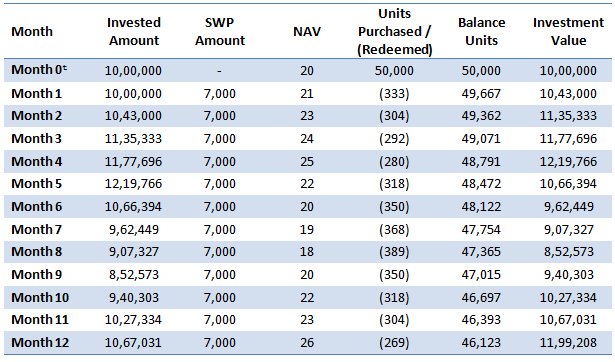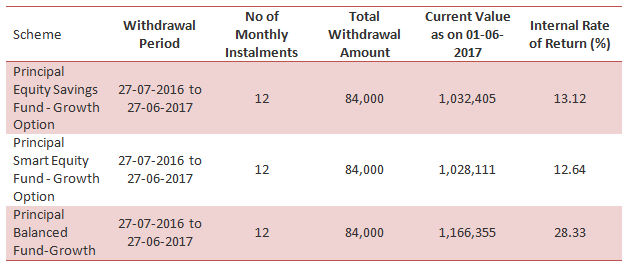Regular Withdrawal Plan: A smart and convenient way of getting regular income

Investors usually depend on Mutual Fund Dividend Option to get regular cash-flows from their investments to meet their income needs. However, mutual fund dividends are not assured. The frequency of dividend pay-out and amount of dividend per unit is at the discretion of the scheme manager. Systematic Withdrawal Plan (SWP) is a less explored but highly effective solution for getting regular income from your investments. Systematic Withdrawal Plan gives investors the flexibility to draw the amount they need from their mutual fund investments at a regular frequency (e.g. monthly).
Principal Mutual Fund has recently rechristened their Systematic Withdrawal Plan (SWP) with a new nomenclature, Regular Withdrawal Plan. The change is not just with respect to the name of the facility, the AMC has enhanced the erstwhile Systematic Withdrawal Plan with a very interesting feature, which makes Regular Withdrawal Plan (RWP) more convenient and beneficial for investors compared to other Systematic Withdrawal plans. We will discuss the enhanced feature later in this post. Let us first understand how Systematic Withdrawal Plan / Regular Withdrawal Plan works.
How does SWP / RWP work?
Let us assume you have invested Rs 10 lakhs in lump sum in a mutual fund scheme and you withdraw Rs 7,000 on the 1st of every month through SWP. The table below shows the monthly unit balances and investment values (Net Asset Values are hypothetical). Exit Load is ignored in this example.

t Month 0 is when the investment is made
You can see that in the SWP / RWP, units were deducted from your initial allotment every month based on the prevailing NAVs. If NAVs went up, less number of units was deducted and if NAV went down, more number of units was deducted. While the changing NAVs reflect the market volatility, you were able to draw a fixed amount every month. You can see that your investment values in some months were lower than your initial investment amount. This was due to falling NAVs and your withdrawals every month. However, over a period of time, as long as your rate of withdrawal is lower than the average growth in NAV, your investment value will not fall below the original investment amount.
Many investors, who have used both SWP and dividend options for regular income, have told us that, they find SWP to be more convenient because the cash-flows are predictable and can be tailored to their personal needs. However, some financial advisors have told us that, one challenge which some of their investor clients face in SWP is exit load, for withdrawals within the exit load period. In the example above, we had ignored exit load for the sake of simplicity. However, mutual fund schemes which have exit loads will deduct the load for all SWP withdrawals made within the exit load period. In order to circumvent exit load, financial advisors ask their clients to postpone SWP till the exit load period is over.
However, this may be challenging for investors who do not have other sources of income. To such investors, advisors recommend that, they should not invest their investment amount in the fund of their choice, but set aside a portion, equal to their income needs during the exit load period in a no load (zero exit load) fund like money market mutual funds and invest the balance amount in the fund of their choice. Investors can make withdrawals from the money market fund during the exit load period of the main fund and then start making withdrawals from the main fund once the exit load period is over. While this is a sound advice, there is a compromise involved because a money market fund like liquid fund is likely to give lower returns than other fund categories in normal market conditions and therefore, the investor loses on returns, to the extent he / she invests in a money market fund to avoid exit load in SWP.
Regular Withdrawal Plan
Principal Mutual Fund offers Regular Withdrawal Plans, which if opted in three schemes, Principal Equity Savings Fund, Principal Smart Equity Fund and Principal Balanced Fund allows the investors to withdraw up to 24% of their initial investments without exit load.If investors opt for RWP facility in these three Principal Mutual Fund schemes, they can start making withdrawals (subject to the 24% cap over the exit load period) immediately after investment, without incurring exit load penalties for their withdrawals.
Advantages of Regular Withdrawal Plans for these three schemes
RWP offers the flexibility of getting fixed cash-flows every month, similar to what investors can get from fixed income like bank term deposits (FDs), Post Office Schemes and Annuities paid by Life Insurance companies etc., and at the same time potentially get higher returns. The table below shows returns of a hypothetical Rs 7,000 monthly RWP from Rs 10 lakh lump sum investment in Principal Equity Savings Fund, Principal Smart Equity Fund and Principal Balanced Fund over the last one year. You can see that, the investor could have drawn Rs 7,000 every month from a lump sum investment of Rs 10 lakhs, implying a withdrawal rate of 8.4% which is higher than the interest paid by bank term deposits (FDs) and most Post Office small savings schemes in the last 12 months.

Source: Advisorkhoj SWP Calculator
Even after making withdrawals @ of 8.4% per annum through RWP, the investment value rose after 12 months. The internal rate of return of the RWP from these schemes ranged from 12.6 to 28%. However, it is important for investors to understand, that mutual funds are subject to market risks and there is no assurance that, these returns will be sustained in the future.
Data has shown that, over a sufficiently long investment horizon, equity as an asset class, gives significantly higher than risk free returns, but there may be periods of volatility in between. Withdrawals made during market slowdowns will reduce investible balances and lower returns. Therefore, investors should ensure that, their withdrawal rate is lower or at least matches, average returns over a sufficiently long period, which includes market corrections.
RWP is also a more tax efficient option for getting regular cash-flows compared to many fixed income products. Interest paid by most fixed income products are taxed as per the income tax rate of the investor. Capital gains arising out of RWP from equity oriented funds like Principal Equity Savings Fund, Principal Smart Equity Fund and Principal Balanced Fund are tax free for all withdrawals made one year after the date of investment. Capital gains on withdrawals made within one year from the date of purchase are taxed 15%.
As discussed earlier, RWP from Principal Equity Savings Fund, Principal Smart Equity Fund and Principal Balanced Fund has no exit load (subject to the 24% cap over the exit load period). The liquidity offered by RWP opted in these schemes is superior to the liquidity offered by other SWPs in the market.
Who should invest?
Investors who want regular cash flows from their investments can opt for RWP in Principal Equity Savings Fund, Principal Smart Equity Fund and Principal Balanced Fund (depending on their risk profiles), if they want immediate cash-flows.
Principal Balanced Fund is one of the best performing balanced funds currently. The fund has given nearly 27% returns in the last one year. This is an equity oriented hybrid fund. The equity allocation is currently around 66%. This fund is suitable for moderately aggressive investors.
Principal Smart Equity Fund is an asset allocation fund. It will allocate monies to debt and equity depending on the relative equity market valuation (P/E ratio). If equity valuation is high the fund will allocate more to debt and vice versa. In the last one year, this fund has given nearly 12% returns. This fund is suitable for investors with moderate risk appetites.
Principal Equity Savings fund is suitable for investors with moderately low risk appetites. This fund invests in equities, fixed income and arbitrage opportunities. This risk profile is much more conservative than traditional balanced funds, because a significant portion is invested in arbitrage which in theory is risk free. However, this fund enjoys equity taxation. In the last one year, this fund has given around 11% returns. This fund is suitable for investors with moderately low risk appetites.
Conclusion
In this post, we discussed how Regular Withdrawal Plans offered by Principal Mutual Fund for three schemes, Principal Equity Savings Fund, Principal Smart Equity Fund and Principal Balanced Fund are smart investment options for getting regular fixed cash-flows from your investments. The three schemes have delivered good performance over the last 12 months. Investors should discuss with their financial advisors if RWP in these schemes is suitable for their investment needs.
Mutual Fund Investments are subject to market risk, read all scheme related documents carefully.
RECOMMENDED READS
- SWP from Debt Mutual Funds give the most tax efficient income over fixed deposits
- Combination of Home Loan EMI and Mutual Fund SIP can save you lot of money
- Systematic Withdrawal Plans from Debt Mutual Funds give the most tax efficient income
- How to select the right debt mutual funds for your portfolio: Part 1
- How to select the right debt mutual funds for your portfolio: Part 3
LATEST ARTICLES
- Different types of diversified equity mutual funds: Schemes from Principal MF stable
- Principal Equity Savings Fund: For investors who look for regular income and capital appreciation
- Mutual Fund ELSS schemes: best way to save tax and create wealth
- What are Balanced Mutual Funds
- How to select the right debt mutual funds for your portfolio: Part 3
We understand what you're working for
We are committed towards helping individuals, businesses & institutional clients achieve financial security & success.
Quick Links
Product Brochures
More About Principal MF
POST A QUERY




